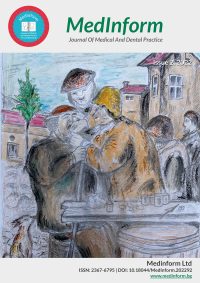Issue Two 2022
2022, Vol. 9, issue 2, (September)
Literature Review
Dry socket (Alveolar osteitis): Aetiopathogenesis, prevention and treatment- literature review
Abstract:
Background: Alveolar osteitis (AO) or fibrinolytic osteitis is one of the most common complications following tooth extraction. The aetiopathogenesis and prevention of this condition has been a subject of debate throughout the years. Assessment of risk factors can guide the physician to minimize the incidence of this complication. Various types of treatment have been suggested although there is yet no universally accepted protocol.
The aim of this critical review is to highlight the oral surgeons and doctors of dental medicine on contemporary concepts about etiology, pathogenesis, treatment and prevention of alveolar osteitis.
Material and methods: An electronic search was performed in PubMed, Google Scholar, ResearchGate and Web of Science. All types of study designs were included in this literature review from articles published from 2007 until 2022, written in English.
Results: Regarding the aetiopathogenesis smoking, oral contraceptives, bacterial infections, trauma during extraction, angiogenesis/fibrinolysis, comorbidity and the usage of vasoconstrictor in anaesthetic solution are known as factors that positively correlate the formation of alveolar osteitis. Age and gender showed inconclusive results. Furthermore, in cases with multiple extractions, open surgical methods and periodontal involvement there is low incidence of alveolar osteitis. Pre- and postoperative mouthwash with 0.12% chlorhexidine have proven to be an effective means for the prevention
|
|
of alveolar osteitis such as copious saline irrigation, topical antibiotics and proper suturing. There is dispute in the usage of systemic antibiotics regarding its effectiveness in the prevention. Irrigation and application of topical anaesthetics and antiseptics can encourage mucosal healing effect.
Conclusion: The results strongly insinuate that the aetiopathogenesis is multifactorial. The ubiquity of alveolar osteitis is inevitable, although there are methods that can reduce its incidence. Alveolar osteitis in most of cases is a self-limiting complication and its treatment is symptomatic.
Keywords: alveolar osteitis, dry socket, etiopathogenesis, prevention, management
Authors:
Elitsa Deliverska; Department of Dental, Oral and Maxillofacial Surgery, Faculty of Dental Medicine, Medical University- Sofia;Argyro Nikolaidou; Student at Faculty of Dental Medicine, Medical Faculty- Sofia;
Kardo Rawanduzy; Student at Faculty of Dental Medicine, Medical Faculty- Sofia;
Janet Kirilova; Department of Conservative dentistry, Faculty of Dental Medicine, Medical University- Sofia;
Tsvetomir Aleksandrov; Military Medical Academy- Sofia;

